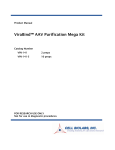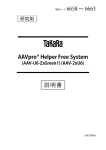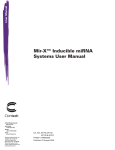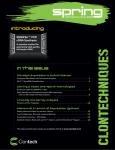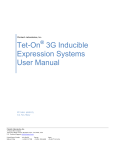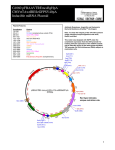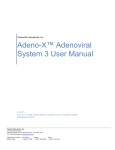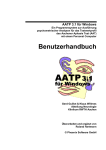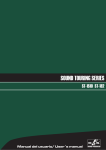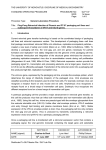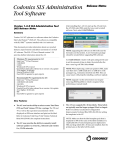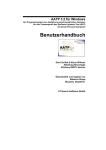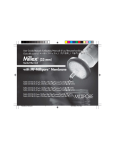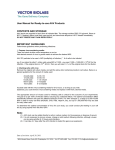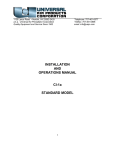Download AAVpro® Purification Kit (All Serotypes)
Transcript
Cat. # 6666 For Research Use AAVpro® Purification Kit (All Serotypes) Product Manual v201508Da AAVpro Purification Kit (All Serotypes) Cat. #6666 v201508Da Table of Contents I. Introduction...................................................................................................... 4 II. Description......................................................................................................... 4 III. Components..................................................................................................... 6 IV. Storage................................................................................................................ 6 V. Materials Required but not Provided...................................................... 6 VI. Protocol............................................................................................................... 7 VII. Experimental Examples ............................................................................... 9 VIII. Related products...........................................................................................11 2 URL:http://www.takara-bio.com AAVpro Purification Kit (All Serotypes) Cat. #6666 v201508Da Safety & Handling of Adeno-Associated Virus Vectors The protocols in this User Manual require the handling of adeno-associated virus vectors. It is imperative to fully understand the potential hazards of and necessary precautions for laboratory use of these vectors. Viruses produced with AAV-based vectors could, depending on your gene insert, be potentially hazardous. Similar vectors have been approved for human gene therapy trials, attesting to their potential ability to express genes in vivo . For these reasons, due caution must be exercised in the production and handling of any recombinant viruses. Follow all applicable guidelines for research involving recombinant DNA. Take appropriate safety measures when producing or handling recombinant adeno-associated viruses, including working in a biological safety cabinet and wearing protective laboratory coats, face protection, and gloves. URL:http://www.takara-bio.com 3 AAVpro Purification Kit (All Serotypes) Cat. #6666 v201508Da I. Introduction Adeno-Associated Virus (AAV) is a non-enveloped virus that belongs to the Parvovirus family of the Dependovirus genus. There are more than 100 serotypes of AAV, and the host specificity and characteristics of the virus differ among serotypes. AAV is not thought to be pathogenic to humans and only replicates in the presence of a helper virus, such as adenovirus or herpesvirus. The AAV genome is a linear, single-strand DNA molecule of approximately 4.7 kb. Adeno-associated virus vectors (AAV vectors) exploit the properties of AAV for transduction of genes to cells and organisms. AAV vectors are used as research tools and also as vectors for gene therapy. In addition, AAV vectors are generally considered safer than adenoviral and retroviral vectors. AAV vectors can be used to transduce genes into both proliferating and non-proliferating cells and can impart long-term expression in non-dividing cells. In addition, AAV has little immunogenicity and is suitable for the transduction of genes into animals (as an in vivo transduction tool). II. Description The purity and titer of AAV particles are important factors for obtaining efficient and stable gene transfer in cultured cells and individual animals. Cesium chloride density gradient centrifugation and iodixanol ultracentrifugation are conventional methods used to purify AAV particles. However, these methods are time consuming, and require specialized equipment and advanced techniques. The AAVpro Purification Kit (All Serotypes) can be used to easily purify AAV particles from AAVproducing cells in about 4 hours: ・Can be used for any AAV serotype ・High purity and recovery ・No complicated techniques, such as ultracentrifugation ・Contains all buffers required to purify AAV particles from producer cells 4 URL:http://www.takara-bio.com Cat. #6666 AAVpro Purification Kit (All Serotypes) v201508Da AAV-producing cell AAV particle Extraction of AAV particles using Extraction Solution A plus and B Treatment with Cryonase™ Cold-active Nuclease Treatment with Precipitator Filtration by Millex-HV 0.45 μm filter Concentration using Amicon Ultra-15 filter Collection of AAV particle solution Figure 1. Purification of AAV particles using AAVpro Purification Kit (All Serotypes) URL:http://www.takara-bio.com 5 AAVpro Purification Kit (All Serotypes) Cat. #6666 v201508Da III. Components This product contains buffers and columns to perform four AAV purifications from packaging cells in five T225 flasks. 1. 2. 3. 4. 5. 6. 7. 8. AAV Extraction Solution A plus AAV Extraction Solution B Precipitator A* Precipitator B Millex-HV 0.45 μm Amicon Ultra-15, 100 kDa Suspension Buffer Cryonase Cold-active Nuclease 22 ml x 2 4.5 ml 5 ml 2.5 ml 4 4 60 ml x 2 500 μl *: Precipitator A may produce a white precipitate at low temperatures; however this does not affect the quality or performance of this reagent. If a precipitate is present, dissolve completely at 37℃ before use. IV. Storage ・Cryonase Cold-active Nuclease: -20℃ ・All other components: Room temperature V. Material Required but not Provided ・General equipment required for cell culture ・Syringe ・0.5 M EDTA (pH 8.0) [e.g., EDTA Buffer Powder, pH 8.0 (Cat. #T9191)] 6 URL:http://www.takara-bio.com AAVpro Purification Kit (All Serotypes) Cat. #6666 v201508Da VI. Protocol The protocol below describes purification of AAV particles from producer cells five T225 flasks. We recommend using the AAVpro Helper Free Systems (Cat. #6230, 6650-6663*) for the preparation of AAV-producing cells. *: Not all products are available in all regions. Please confirm availability in your region. VI-1. Preparation of AAV extract solution 1. Detach the AAV-producing cells by adding 1/80 volume of 0.5 M EDTA (pH 8.0) to the culture medium; incubate at room temperature for 10 min. 2. Collect the cells from the flask. 3. Centrifuge at 1,700 - 2,000 X g for 10 min at 4℃ and discard the supernatant. 4. Centrifuge again at 1,700 - 2,000 X g for 1 min at 4℃ and remove the supernatant completely. Note: Be sure to completely remove the supernatant, because remaining supernatant could impair virus purification. 5. Loosen the cell pellet well by tapping or vortexing. Note: If the cell pellet is not loosened sufficiently, the purification efficiency can be decreased. Make sure there are no cell clumps before proceeding to the next step. 6. Add 10 ml of AAV Extraction Solution A plus. 7. Resuspend for 15 sec by vortexing. Note: Continue to vortex until there are no remaining cell clumps. 8. Incubate for 5 min at room temperature and then vortex again for 15 sec. 9. Centrifuge at 4,000 - 9,000 X g for 10 min at 4℃ Note: In some cases, the efficiency can be improved by repeating steps 7 - 9. 10. Collect supernatant in a new sterile centrifuge tube using a pipet to avoid contamination. Add 1/10 volume of AAV Extraction Solution B. Note 1: The sample can be stored at -80℃ at this stage. Alternatively, promptly proceed to step VI-2-1. If the sample is stored at -80℃, thaw in a 37℃ incubator before using. Be sure to use a tube that is resistant to freezing and centrifugation when a sample is stored at -80℃. Note 2: When AAV Extraction Solution B is added, the color of the solution may turn pink in some cases; this does not affect performance. URL:http://www.takara-bio.com 7 AAVpro Purification Kit (All Serotypes) Cat. #6666 v201508Da VI-2. Purification and concentration of AAV particles Note: Use swinging bucket rotors for steps VI-2-5, VI-2-6, and VI-2-7. 1. Add 1/100 volume of Cryonase Cold-active Nuclease to the solution from step VI-1-10, and then incubate at 37℃ for 1 hr. 2. Add 1/10 volume of Precipitator A, vortex for 10 sec, incubate at 37℃ for 30 min, and vortex again for 10 sec. Note 1: Precipitator A may produce a white precipitate at low temperatures, however this does not affect the quality or performance of this reagent. If a precipitate is present, dissolve it completely at 37℃ before use. Note 2: Although a precipitate may form during the reaction, this is not a problem. Proceed to the next step. 3. Add 1/20 volume of Precipitator B to the solution, promptly vortex for 10 sec, and then centrifuge at 5,000 - 9,000 X g for 5 min at 4℃. Note: A precipitate is formed after adding Precipitator B, proceed to centrifugation. 4. Filter the supernatant using a Millex-HV 0.45 μm filter. 5. Add the filtrate containing AAV vector to an Amicon Ultra-15,100 kDa filter. Centrifuge at 2,000 X g for 5 min at 15℃, and then confirm that the AAV solution in the filter is <1.5 ml. Note: If the volume of the solution is >1.5 ml, continue to centrifuge. 6. After removing the filtrate, add 5 ml of Suspension Buffer inside the cup of the Amicon Ultra-15 filter unit and mix the solution uniformly by pipetting. Centrifuge at 2,000 X g for 5 min at 15℃, and then confirm that the AAV solution inside the filter is <1.5 ml. Note: If the volume of the solution is >1.5 ml, continue to centrifuge. 8 7. Repeat step VI-2-6 4 times (total 5 times) to obtain an appropriate volume of solution. 8. After discarding the filtrate, resuspend the solution inside of the cup of the Amicon Ultra-15 (100 kDa) filter unit by pipetting or vortexing for 30 sec and transfer the solution to a new tube. URL:http://www.takara-bio.com Cat. #6666 AAVpro Purification Kit (All Serotypes) v201508Da Vll. Experimental Examples VII-1. Purity of each AAV serotype after purification AAV particles carrying the fluorescent protein ZsGreen1 were prepared from producer cells in five T225 flasks. The AAV solution was purified using this product, and then titer was measured using the AAVpro Titration Kit (for Real Time PCR) Ver.2 (Cat. #6233). SDSPAGE was performed using 1 x 109 vector genome (vg) per lane. The AAV capsid proteins (VP1, VP2, and VP3) were confirmed to be the major bands present. AAV Serotype M 1 2 3 5 6 ← VP1 ← VP2 ← VP3 M : Protein Molecular Weight Marker (Broad) (Cat. #3452) URL:http://www.takara-bio.com 9 Cat. #6666 AAVpro Purification Kit (All Serotypes) v201508Da VII-2. Infectivity of purified AAV particles ZsGreen positive cells [%] 10 80 60 40 20 0 CHO RD HT1080 AAV3 100 80 60 40 20 0 CHO RD HT1080 ZsGreen positive cells [%] AAV1 100 ZsGreen positive cells [%] ZsGreen positive cells [%] ZsGreen positive cells [%] The infectivity of the AAV particles obtained above was evaluated. Cells were infected with purified AAV vectors at 5,000 vg/cell (serotypes 1, 2, 3, and 6) or 50,000 vg/cell (serotype 5). Flow cytometry analysis was performed 3 days later to determine infection efficiency. The AAV particles purified using this kit were able to infect various cell lines. AAV2 100 80 60 40 20 0 CHO RD HT1080 AAV5 15 10 5 0 CHO RD HT1080 AAV6 100 80 60 40 20 0 CHO RD HT1080 URL:http://www.takara-bio.com AAVpro Purification Kit (All Serotypes) Cat. #6666 v201508Da VIII. Related products AAVpro® Helper Free System (AAV2) (Cat. #6230) AAVpro® Helper Free System (AAV5) (Cat. #6650) AAVpro® Helper Free System (AAV6) (Cat. #6651) AAVpro® Helper Free System (AAV2-CRE Recombinase) (Cat. #6652) AAVpro® Helper Free System (AAV5-CRE Recombinase) (Cat. #6653) AAVpro® Helper Free System (AAV6-CRE Recombinase) (Cat. #6654) AAVpro® Helper Free System (AAV2-LacZ) (Cat. #6655) AAVpro® Helper Free System (AAV5-LacZ) (Cat. #6656) AAVpro® Helper Free System (AAV6-LacZ) (Cat. #6657) AAVpro® Helper Free System (AAV2-U6-ZsGreen1) (Cat. #6658) AAVpro® Helper Free System (AAV5-U6-ZsGreen1) (Cat. #6659) AAVpro® Helper Free System (AAV6-U6-ZsGreen1) (Cat. #6660) AAVpro® Helper Free System (AAV2-2xU6) (Cat. #6661) AAVpro® Helper Free System (AAV5-2xU6) (Cat. #6662) AAVpro® Helper Free System (AAV6-2xU6) (Cat. #6663) pAAV-ZsGreen1 Vector (Cat. #6231) AAVpro® Packaging Plasmid (AAV2) (Cat. #6234) AAVpro® Packaging Plasmid (AAV5) (Cat. #6664) AAVpro® Packaging Plasmid (AAV6) (Cat. #6665) AAVpro® Titration Kit (for Real Time PCR) Ver.2 (Cat. #6233) EDTA Buffer Powder, pH8.0 (Cat. #T9191) Note: Not all products are available in all regions. Please confirm availability in your region. AAVpro is a registered trademark of TAKARA BIO INC. Cryonase is a trademark of TAKARA BIO INC. NOTE : This product is for research use only. It is not intended for use in therapeutic or diagnostic procedures for humans or animals. Also, do not use this product as food, cosmetic, or household item, etc. Takara products may not be resold or transferred, modified for resale or transfer, or used to manufacture commercial products without written approval from TAKARA BIO INC. If you require licenses for other use, please contact us by phone at +81 77 565 6973 or from our website at www.takara-bio.com. Your use of this product is also subject to compliance with any applicable licensing requirements described on the product web page. It is your responsibility to review, understand and adhere to any restrictions imposed by such statements. All trademarks are the property of their respective owners. Certain trademarks may not be registered in all jurisdictions. URL:http://www.takara-bio.com 11











